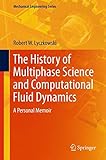The History of Multiphase Science and Computational Fluid Dynamics [electronic resource] : A Personal Memoir / by Robert W. Lyczkowski.
By: Lyczkowski, Robert W [author.] .
.
Contributor(s): SpringerLink (Online service) .
.
Material type:  BookSeries: Mechanical Engineering Series: Publisher: Cham : Springer International Publishing : Imprint: Springer, 2018Edition: 1st ed. 2018.Description: XVII, 334 p. 19 illus., 4 illus. in color. online resource.Content type: text Media type: computer Carrier type: online resourceISBN: 9783319665023.Subject(s): Fluid mechanics
BookSeries: Mechanical Engineering Series: Publisher: Cham : Springer International Publishing : Imprint: Springer, 2018Edition: 1st ed. 2018.Description: XVII, 334 p. 19 illus., 4 illus. in color. online resource.Content type: text Media type: computer Carrier type: online resourceISBN: 9783319665023.Subject(s): Fluid mechanics1. Introduction -- 2. Cleveland State University, Cleveland 1959 – 1964 -- 3.Illinois Institute of Technology (IIT), Chicago 1964 – 1970 -- 4. The Seeds are sown by Larry Ybarrondo in a stet far away, Idaho Falls, Idaho -- 5. Project Development begins -- 6. Characteristics analysis of the one-dimensional, two-fluid partial differential equations (PDEs) developed by Chuck Solbrig and Dan Hughes -- 7. The SLOOP code development -- 8 The Characteristics Paper Caper -- 9. RETRAN is Initiated at Energy Incorporated for EPRI hiring the core SLOOP code -- 10. RELAP5 is initiated by Victor Ransom and Dick Wagner funded by Ybarrondo -- 11. USDOE Starts Code Development at S Cubed and Jaycor to Address the Energy Crisis Caused by the Oil Embargos -- 12. Reactor Safety research Group breaks from T-3 Division -- 13. IIT code begins Using Los Alamos’ K-FIX Code -- 14. METC starts MFIX Code development using FLUFIX Code -- 15. FLUENT Code Debuts at Creare, Inc. and CFX -- 16. COMMIX Code Development at Argonne National Laboratory -- 17. International Conferences and Workshops addressing Multiphase needs and Problems begin -- 18. DOE OIT Center for Multiphase Dynamics Effort begins becomes the MDFRC -- 19. Gidaspow publishes First Book “Multiphase Flow and Fluidization Continuum and Kinetic Theory Descriptions” -- 20. NETL initiates Workshops on Multiphase Flow Research later called Multiphase Flow Science -- 21. The NETL Multiphase Flow Research “Roadmap” Document and its Critique -- 22. Gidaspow publishes Second Book “Computational Techniques: The Multiphase CFD Approach and Green Energy Technologies” -- 23. Conclusion - What Does the Future Hold?. .
This book tells the story of how the science of computational multiphase flow began in an effort to better analyze hypothetical light water power reactor accidents, including the “loss of coolant” accident. Written in the style of a memoir by an author with 40 years’ engineering research experience in computer modeling of fluidized beds and slurries, multiphase computational fluid dynamics, and multiphase flow, most recently at Argonne National Laboratory, the book traces how this new science developed during this time into RELAP5 and other computer programs to encompass realistic descriptions of phenomena ranging from fluidized beds for energy and chemicals production, slurry transport, pyroclastic flow from volcanoes, hemodynamics of blood-borne cells, and flow of granular particulates. Such descriptions are not possible using the classical single-phase Navier-Stokes equations. Whereas many books on computational techniques and computational fluid dynamics have appeared, they do not trace the historical development of the science in any detail, and none touch on the beginnings of multiphase science. A robust, process-rich account of technologic evolution, the book is ideal for students and practitioners of mechanical, chemical, nuclear engineering, and the history of science and technology. Imparts a personal narrative tracing the critical events in the initiation, development, and propagation of multiphase science and computational fluid dynamics in its historical context; Reveals the amazing chain of incidents and coincidences but for which multiphase science and computational fluid dynamics would never have evolved; Presents in narrative form many facets of multiphase science (MPS), including sand grains, bubbles, and water droplets and how MPS differs from single-phase science; Describes the development of what came to be called the seriated loop (SLOOP) code, intend ed to replace the RELAP4 code, used to perform safety studies for and to license nuclear reactors and the politics of science that led to its demise. .


There are no comments for this item.